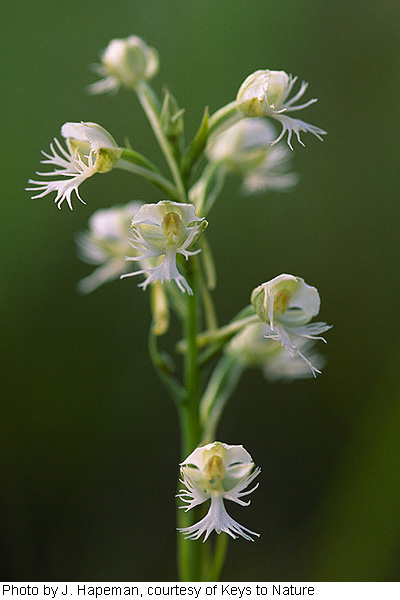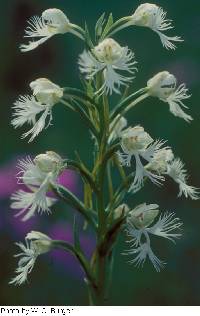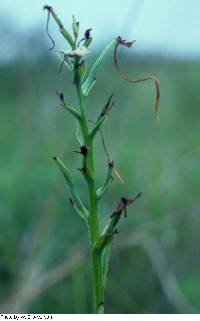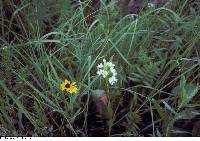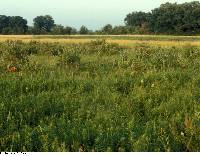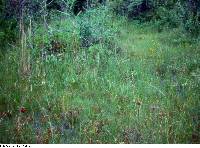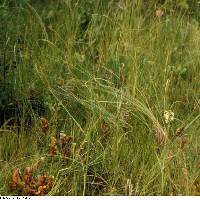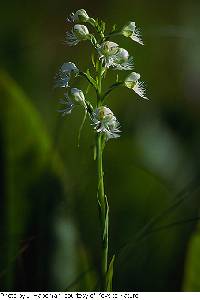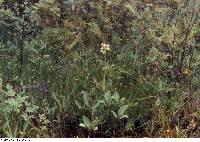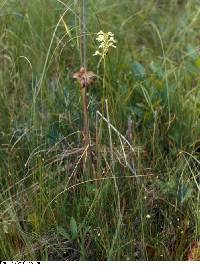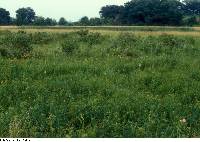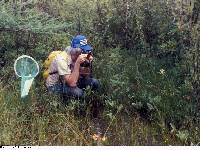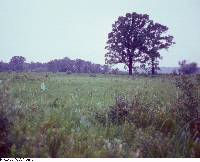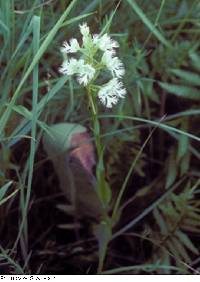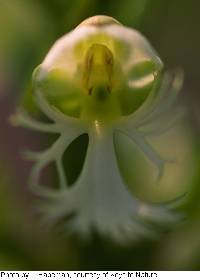Platanthera leucophaea
|
|
|
|
Family: Orchidaceae
Prairie White Fringed Orchid, more...Eastern prairie fringed orchid
[Blephariglottis leucophaea, moreHabenaria leucophaea (Nutt.) A. Gray, Habenaria leucophaea var. leucophaea , Orchis leucophaea] |
Plants 32-112 cm. Leaves several to many, ascending, scattered along stem, imperceptibly reduced to bracts distally; blade lanceolate to ovate-lanceolate, usually to 20 × 4 cm. Spikes lax to moderately dense. Flowers resupinate, showy, corolla white, calyx green to whitish green; lateral sepals porrect; petals obovate to rarely flabellate, apically lacerate; lip descending to horizontally projecting, deeply 3-lobed, without basal thickening, 14-22 × 15-29 mm, distal margins of lobes deeply incised, fringed, lateral lobes flabellate, usually broad, overlapping middle lobe, middle lobe flabellate, sometimes very broadly, emarginate; spur slenderly clavate, 28-47 mm; rostellum lobes nearly parallel, directed downward, short, rounded; pollinaria geniculate; pollinia directed forward (column appearing hooded), remaining enclosed in anther sacs; viscidia orbiculate; ovary slender, mostly 15-30 mm. 2n = 42. Flowering Jun--Aug. Mesic to wet prairies, marshes, fens, lake shores, old fields; of conservation concern; 80--300 m; Ont.; Ill., Ind., Iowa, La., Maine, Mich., Mo., Nebr., N.J., N.Y., Ohio, Okla., Va., Wis. A very rare hybrid with Platanthera psycodes, known only from Ontario, is P. × reznicekii Catling, Brownell & G. Allen. See the discussion under 22. Plantanthera praeclara.
Perennial herb 20 - 100 cm tall Stem: single, erect, green, angled, hairless, and leafy. Leaves: three to several, alternate, ascending to flaring, stalkless, clasping at base, silver-green, hairless, non-toothed, more or less lance-shaped (always longer than wide and widest near base) with narrow pointed tip, and strong lengthwise ridge or keel on underside. The two lowest leaves are the largest at 8 - 20 cm long and 1.5 - 5 cm wide, with the remaining leaves slightly reduced in size going up the stem. Inflorescence: a single, erect, terminal, stout, hairless, showy, large (8 - 20 cm tall), spike-like cluster of ten to forty stalked flowers with each flower subtended by a 1 - 4 cm long, narrowly lance-shaped, tapering, pointed, non-toothed, hairless bract. Flowers: stalked, strongly fragrant, showy, creamy white, hairless, over 3 cm diameter, bilaterally symmetric with center sepal and upper petals above the prominent, highly modified, three-lobed, fringed lip petal, which has base modified into a long, thin nectar spur. The reproductive parts of stamens, stigma and style are fused into a somewhat round-topped column above the 1.5 - 3 cm long slender inferior ovary. Sepals: three, petal-like, partially spreading with tips curving forward, green to whitish green, 0.7 - 1.5 cm long, 4 - 8 mm wide, egg-shaped, hairless, non-toothed. The central, uppermost sepal is closely positioned with the lateral petals, and arches over the lip petal and column. Fruit: several, erect, stalked, ellipsoid capsules with many seeds. Roots: fleshy, thickened near base. Lateral petals: two, close together, spreading upward and forward, white to creamy white, hairless, 0.8 - 1.5 cm long, 4 - 8 mm wide, fan- or wedge-shaped, narrowest at base, and irregularly finely toothed along wide upper edge. Lip petal: one, central, lowermost, projecting forward or downward, creamy white, hairless, 1.4 - 2.5 cm long, 1.5 - 2.9 cm wide, widely egg-shaped in outline, but deeply three-lobed with each lobe trimmed by deep narrow fringe along edge. The base of the lip petal is modified into a curved, 2 - 3.5 cm long, slenderly club-shaped spur. Similar species: Platanthera leucophaea is most similar to its close western relative, P. praeclara, but that species only occurs west of the Mississippi River and can be distinguished by its typically shorter and few-flowered inflorescence (up to sixteen flowers), its larger flowers (lip 1.7 - 3.3 cm long, 2 - 4 cm wide, spur 3.5 - 5.3 cm long), more forward-facing lateral petals, and distinctly different column structure, which tends to be more angular with the pollinia spread apart by at least 6 mm. Within our area, P. leucophaea is likely to be confused with pale-flowered individuals of P. lacera, but that species has flowers with the lateral petals linear to linear-oblong and non-toothed, a much more deeply fringed lip petal (cut nearly to base of each lobe instead of only halfway), and the spur is usually shorter (0.8 - 2.3 cm long). It is possible a white-flowered plant of P. psycodes could also be confusing, but in general the stem has fewer leaves which noticeably reduce in size upward, and the flowers are smaller (lip under 1.5 cm long and wide, spur at most 2 cm long, sepals and lateral petals under 0.7 cm long and up to 4 mm wide). Another possibly confusing species is P. blephariglottis, but the white flowers have a non-lobed lip petal that although fringed, is tongue-shaped or oblong. Flowering: June and July Habitat and ecology: Very rare, almost exclusively in mesic or wet prairies, though also found in other open wetlands such as sedge meadows and marshes as long as they are not too alkaline. Occurence in the Chicago region: native Notes: The flowers of Platanthera leucophaea are most fragrant at dusk, which coincides with visitation by moths. Hawkmoths are the only known pollinators of P. leucophaea, but its closest relative, P. praeclara (the western prairie fringed orchid), which occurs west of the Mississippi River has a different pollinator (Sheviak and Bowles 1986). The eastern prairie fringed orchid was once common throughout Midwestern wet prairies but is now found in fewer than sixty locations. Most of the populations have been lost through destruction or modification of habitat. Conservation research is underway to increase current population sizes and reintroduce this orchid in restored prairies (Zettler et al. 2001). Etymology: Platanthera comes from the Greek words platys, meaning flat or broad, and anthera, meaning anther, which refers to the wide anther of the genus. Leucophaea comes from the Latin words leuco, meaning white, and phaeo, meaning dim or dark, which refers to the off-white flowers. Author: The Field Museum Stem 4-10 dm; lower lvs lanceolate to broadly linear, 10-20 cm, commonly blunt; upper lvs much reduced; spike cylindric, 8-20 נ5-7 cm; lip and lateral pet white or creamy, the sep green or greenish-white; sep broadly oval to obovate, 7-13 mm; lateral pet broadly obovate-cuneate, toothed, slightly longer than the sep; lip deeply 3-lobed, the terminal lobe short-clawed, very broadly cuneate, usually deeply notched in the center, long-fringed, the lateral lobes fringed to the middle or below; spur slender and elongate; 2n=42. Wet prairies from Mich. and O. to N.D., Nebr., Kans. and La., and rare in bogs and marshes from N.S. and Ont. to O. June, July. Two well marked, largely allopatric, but very similar vars., partly isolated by differences in pollinators. Gleason, Henry A. & Cronquist, Arthur J. 1991. Manual of vascular plants of northeastern United States and adjacent Canada. lxxv + 910 pp. ©The New York Botanical Garden. All rights reserved. Used by permission. Fls smaller, the lateral pet mostly 8-11 נ4.5-7 mm, the lip 15-21 mm, the spur 30-40 mm; column comparatively small and rounded, the pollinaria closely spaced, their caudicles parallel, the viscidia directly below the pollinia; mainly eastern, extending w. to Ill., Wis., se. Io., and rarely to e. Kans. and e. Okla. (Blephariglottis l.; Platanthera l.) Gleason, Henry A. & Cronquist, Arthur J. 1991. Manual of vascular plants of northeastern United States and adjacent Canada. lxxv + 910 pp. ©The New York Botanical Garden. All rights reserved. Used by permission. From Flora of Indiana (1940) by Charles C. Deam Probably local in the lake area years ago but now rare. I have found it in only five places. In addition to these counties it has been reported from the following counties: Hamilton, Kosciusko, Lake, and Marshall. My specimens are from sphagnum in tamarack bogs. …… Indiana Coefficient of Conservatism: C = 10 Wetland Indicator Status: FACW |
|
|
|

